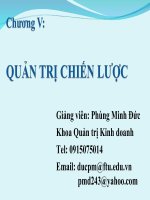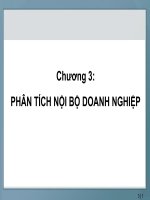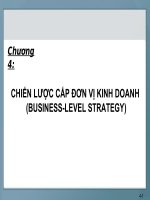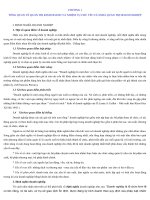Bài giảng quản trị kinh doanh quốc tế chương 5 Chiến lược kinh doanh quốc tế GV nguyễn hùng phong
Bạn đang xem bản rút gọn của tài liệu. Xem và tải ngay bản đầy đủ của tài liệu tại đây (629.22 KB, 72 trang )
Chương 5: Chiến lược kinh doanh
quốc tế
I. Chiến lược toàn cầu
II. Xâm nhập thị trường quốc tế
III. Marketing toàn cầu
IV. Điều hành sản xuất toàn cầu
V. Quản trị nguồn nhân lực toàn cầu
I. Chiến lược toàn cầu
Chiến lược:
“hàng động mà quản trị gia tiến hành để
đạt được mục tiêu của công ty”
Mục tiêu chung:
Tối đa hóa lợi ích/lợi nhuậnKhác biệt hóa sản
phẩm; tăng giá bán thông qua việc gia tăng
các giá trị, đặc tính sản phẩm, chất lượng, dịch
vụ
Hạ thấp chi phí
Phương tiện : Phân bố các nguồn lực hạn
chế để đạt mục tiêu
Các hoạt động trong chuổi giá trị
Hoạt động của công ty nhằm kết nối các
chuổi giá trị để đạt hiệu quả cao nhất
Các hoạt động chủ yếu
,Hậu cần, sản xuất , marketing, bán hàng, dịch vụ sau
bán hàng
Các hoạt động hổ trợ
Cơ sở hạ tầng, nguồn nhân lực, nghiên cứu và phát
triển, công nghệ, cung ứng
Lợi ích từ việc mở rông kinh doanh
toàn cầu
Gia tăng lợi nhuận từ các kỹ năng chuyên
biệt, năng lực cạnh tranh cốt lõi
Là các kỹ năng, năng lực khó bắt chước
Nhận dạng lợi thế từ việc phân bố địa lý
Hình thành mạng lưới hoạt động toàn cầu
Tận dụng hiệu ứng kinh nghiệm, giảm
thấp phí tổn, tăng năng suất
Xem đường cong kinh nghiệm
Lợi ích từ việc mở rông kinh doanh toàn
cầu
B
Tổng sản lượng sản phẩm
Đường cong
kinh nghiệm
Chi phí cho
Một đơn vị
A
Áp lực toàn cầu hóa và đáp ứng yêu cầu
quốc gia
Cao
Cao
Thấp
Thấp
Áp lựchợp nhất
toàn cầu
(giãm phí tổn)
Áp lực đáp ứng yêu cầu quốc gia
Sự khác biệt do
- Thị hiếu
-Cơ sở vật chất hạ tầng
-Kênh phân phối
-Nhu cầu của nhà nước sở tại
Lúa mì
Mỹ phẩm, thực phẩm,
Đồ dùng gia đình
Các loại chiến lược
Cao
Cao
Thấp
Thấp
Áp lực đáp ứng yêu cầu quốc gia
Chiến lược
Toàn cầu
Chiến lược
Xuyên quốc gia
Chiến lược
Đa thị trường
Chiến lược
Quốc tế hóa
Áp lực hợp nhất
Toàn cầu
(giảm chi phí)
Four Strategic alternatives
International strategy
historic illustration
1920s 1930s 1940s 1950s 1960s 1970s
European MNCs
Japanese MNCs
American MNCs
Period of Internationalisation
Operating Environment
Protectionism
Local competitors
Communication/
Transport. barriers
Org. culture
Multidomestic
Global
Home replication
Post-war reconstruct.
Sophisticated home-
market demand
Comm. Technology
Consumer demand
Falling tariff barriers
Cost pressures
Org. culture
S
T
R
A
T
E
G
Y
Strategy in action – Proton
http://203.132.125.42/protonweb/live/me.get?SITE.HOME&FFFF197
Profile: Malaysian car manufacturer, JV between Malaysia govt.
and Mitsubishi (Japan), exports to 50 countries
Strategic objective: Training of local Malays, development of local
industry, access to local market
Internationalisation: Mitsubishi transfers non-cost effective
manufacturing abroad. Proton exports domestically designed and
manufactured cars via an international marketing division.
Benefits from infant industry protection at home and subsidies for
exports
• Which strategy?
Strategy: Result of a home replication strategy by Mitsubishi,
Proton follows an international exporter strategy, undifferentiated,
low cost/price
Home replication strategy
Chuyển giao các kỹ năng/sản phẩm
Dựa trên các năng lực cạnh tranh cốt lỏi
Tìm kiếm các thị trường bên ngoài, mà ở đó :
Các đối thủ cạnh tranh không có những kỹ năng này
Không có những sản phẩm mà chúng ta sản xuất
establish marketing operations in each major
market
limited customisation of product
limited customisation of marketing strategy
Strategy in action – Unilever
/> Profile: 2
nd
largest consumer products firm, production in 70
countries, sales in 158 countries, 400 leading brands, CoO - the
Netherlands, UK
Products: include food (Flora margarine, Lipton tea), detergent
(Persil), toothpaste, deodorant, soap (Dove).
Strategic objective: proximity to customers (national
responsiveness as an advantage over competitors)
Internationalisation: Early (1920s) and dispersed
Which strategy?
Combines a multi-domestic strategy with some coordinated
production and ‘best practice’.
Multidomestic strategy
result: horizontal (flat) organisation
advantages:
able to rapidly respond to changes in
local markets
able to anticipate changes in demand
(tastes and preferences)
disadvantages:
little benefit from either experience or
location economies over time, tendency to
autonomy
lose ability to transfer skills & products
(become less internationally competitive)
Examples: Unilever, Philips
Strategy in action – IKEA
Profile: 140 stores in 30 countries,
CoO-Sweden
Products: Furniture
Strategic objective: Maintain
philosophy of Swedish founder –
furniture (and service) should be high
quality as well as price competitive
(hybrid generic strategy; differentiation
& low cost)
Internationalisation: Rapid using
independent (but strictly monitored)
suppliers to produce standardised
components
Strategy: Used a global strategy to
sell a standardised product worldwide
using a ‘home-base’ formula and
minimal adaptation to local markets.
Global strategy
standardised world wide product
capital intensive production
integrated production chain
standardised marketing, advertising, packaging
aggressive pricing policies
no/extremely limited product differentiation
concentrate functional activities
economies of scale/scope critical advantages
maximise “cost reductions”
Strategy in action – Procter & Gamble
www.pg.com
Profile: US consumer products company
Strategy: Operates locally; sales, marketing, development,
delivery.
‘Project 2005’ groups 200+ brand products into 7 business units,
each coordinated globally from key locations (finance, payroll,
HRM, etc.) to achieve internal EoS
‘Learning organisation’; best practice becomes benchmark for all
subsidiaries
Organisational strategy and structure is transnational: objective is
to achieve economic efficiency and local responsiveness
Transnational strategy
pressures for cost reduction AND local responsiveness
AND worldwide learning
Maximise synergy between global competencies
Efficiency, through EoS and integration (coordination) of
global operations
Responsiveness, with flexibility
geographic
functional
organisational
technological
The “international learning organisation”
key competitive asset: ability to adapt/adopt/respond to benefit
the customer (at the expense of the competitor)
3 synergy & structure
International strategy differs from domestic strategy in that MNEs
are able to draw advantage from:
Configuration of value-adding activities across borders
Co-ordination of value-adding activities across borders (Porter 1986, 1990)
The structure of the multinational enterprise (MNC) should suit the
chosen strategy
By structure we not only mean where the organisation is located, but
also how it is organised.
Strategic
Approach
Multinational International Global
Structure
Decentralised
federation
Coordinated federation Centralised hub
Key strategic
capability/
objective
National
responsiveness
Worldwide transfer of
home country
innovations
Global-scale efficiency
Configuration of
assets &
capabilities
Decentralised &
nationally self-sufficient
Sources of core
competencies
centralised, others
decentralised
Centralised & globally
scaled
Role of overseas
operations
Sensing & exploiting
local opportunities
Adapting & leveraging
parent-co
competencies
Implementing parent-
company strategies
Development &
diffusion of
knowledge
Developed & retained
within each unit
Developed at centre,
transferred to overseas
units
Developed & retained at
the centre
Cơ cấu tổ chức đa thị trường
Liên bang phân quyền: Phân quyền quyết định cho chi nhánh
Kiểm soát lõng lẽo: - quan hệ phi chính thức giửa trung tâm và chi
nhánh , kiểm soát tài chính giản đơn
Tinh thần đa thị trường:- Quản trị gia nhìn các hoạt động hải ngoại
như là một danh mục các hoạt động độc lập
UK
Chile
India
Japan
USA
HK
Mexico
Cơ cấu tổ chức: chiến lược quốc tế
hóa
Liên bang phối hợp:- Phân quyền cho chi nhánh
Hệ thống kiểm soát chặt : - Trung tâm nắm quyền tập trung, kế
hoạch tập trung, quan hệ chặt giửa trung tâm và chi nhánh
Tinh thần Quốc tế hóa: - Quản trị gia xem các hoạt động ở hải ngoại
như phần bổ sung cho hoạt động ở nội địa
UK
Chile
India
Japan
USA
HK
Mexico
Cơ cấu tổ chức: chiến lược
toàn cầu
Trung tâm tập trung hóa: Trung tâm nắm quyền ra quyết định về tài
sản, nguồn lực, các quyết định chủ yếu
Kiểm soát điều hành: - Kiểm soát chặt việc ra quyết định, phân bổ
nguồn lực, thông tin
Tinh thần toàn cầu: - Quản trị gia xem các hoạt độngoại như hệ
thống đường ống phân phối kết nối cho một thị trường toàn cầu hợp
nhất
UK
Chile
India
Japan
USA
HK
Mexico
Xuyên quốc
gia
Tổ chức theo hệ thống mạng :- Phân phối, chuyên môn hóa các nguồn
lực và năng lực
Các đơn vị quốc tế phụ thuộc lẩn nhau: - Dòng dịch chuyển lớn giửa
các chi nhánh về linh kiện, sản phẩm, nguồn lực, con người, và thông tin
Tinh thần xuyên quốc gia: -Quy trình điều phối và hợp tác phức tạp giửa
các đơn vị trên tinh thần chia xẽ trong việc ra quyết định
UK
Chile
India
Japan
USA
HK
Mexico
Các liên minh chiến lược quốc tế
Ký những thỏa thuận hợp tác giửa các đối
thủ cạnh tranh thực tế/tiềm năng từ các
quốc gia khác nhau
Thuận lợi
Hổ trợ việc xâm nhập thị trường nước ngoài
Chia xẽ chi phí cố định cho các sản phẩm và quy
trình mới
Bổ sung các kỹ năng và tài sản không dể dàng phát
triển một mình
Thiết lập được các tiêu chuẩn kỷ thuật chung trong
ngành
Giảm thiểu chi phí hoạt động: chia xẽ chi phí đào tạo,
cung ứng……
Các liên minh chiến lược quốc tế
Bất lợi
Tạo cơ hội cho đối thủ cạnh tranh một cơ hội tiếp
cận kỷ thuật và thị trường với một chi phí thấp
Phân phối lợi ích không tương xứng với đóng góp
của mổi bên sẽ dẩn đến mâu thuẩn









